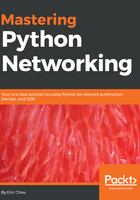
上QQ阅读APP看书,第一时间看更新
Python control flow tools
The if, else, and elif statements control conditional code execution. As one would expect, the format of the conditional statement is as follows:
if expression:
do something
elif expression:
do something if the expression meets
elif expression:
do something if the expression meets
...
else:
statement
Here is a simple example:
>>> a = 10
>>> if a > 1:
... print("a is larger than 1")
... elif a < 1:
... print("a is smaller than 1")
... else:
... print("a is equal to 1")
...
a is larger than 1
>>>
The while loop will continue to execute until the condition is false, so be careful with this one if you don't want to continue to execute:
while expression:
do something
>>> a = 10
>>> b = 1
>>> while b < a:
... print(b)
... b += 1
...
1
2
3
4
5
6
7
8
9
The for loop works with any object that supports iteration; this means all the built-in sequence types such as lists, tuples, and strings can be used in a for loop. The letter i in the following for loop is an iterating variable, so you can typically pick something that make sense within the context of your code:
for i in sequence:
do something
>>> a = [100, 200, 300, 400]
>>> for number in a:
... print(number)
...
100
200
300
400
You can also make your own object that supports the iterator protocol and be able to use the for loop for this object:
Constructing such an object is outside the scope of this chapter, but it is a useful knowledge to have; you can read more about it https://docs.python.org/3/c-api/iter.html.